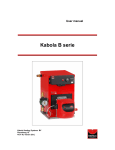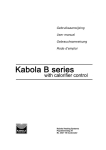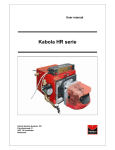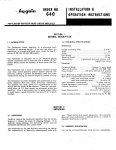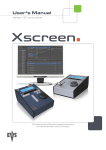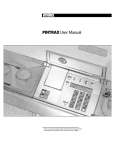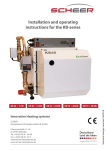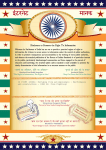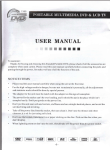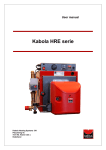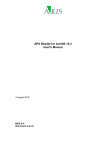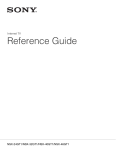Download User Manual - MarineTec US
Transcript
Preface This user-manual is written to enable the safe operation of the B-Series central heating boilers. The user must read this manual before installation of the boiler and must follow the instructions within this manual. The re fore, this ma nual must be ke pt with the boiler. In chapter 2, the safety instructions are detailed, which have to be complied with, when installing and using the boiler. In other chapters you will find safety instructions, that can be identified in the following way. Hint: This gives the user suggestions and advises to facilitate the execution of certain tasks. Atte ntion: Additional information is supplied to the user, and possible problems are indicated. Wa rning: Watch out for possible (life-threatening) injuries. For any remarks, wishes or omissions you can contact Kabola Heating Systems. W e also welcome any remarks to improve this manual. We wish you a lot of pleasure from your purchase. Kabola Heating Systems Populierenweg 41 NL 3421 TX Oudewater The Netherlands Phone +31 (0)348-561277 Fax +31 (0)348-562484 Web: www.kabola.nl E-mail [email protected] Oudewater, 1-4-2005 © 2005 Kabola Heating Systems Copying of (parts of) this manual, is only allowed with written consent of Kabola Heating Systems. Use r ma nual Ka bola B-serie, 1-4-2005 2 Contents Preface Contents 1. Introduction 1.1 General Introduction. 1.2 Range application 1.3 Product description 1.4 Technical specifications 2. Safety 2.1 General safety 2.2 Safety instructions 3. Transport and storage 3.1 Transport 3.2 Storage 4 Installing and preparing for first use 4.1 Installation 4.1.1 Fitting the boiler 4.1.2 Connection of the Central heating system 4.1.3 Flue gas outlet 4.1.4 Electrical installation 4.1.5 Filling the central heating system 4.1.6 Mounting the burner 4.1.7 Connecting the oil filter and oil burner 4.2 Starting your system 5 Operating the boiler 6 Cleaning and maintenance 6.1 Points of attention 6.2 Cleaning and maintenance. 7 End of life of the boiler Appendix A Technical specifications Appendix B Parts Appendix C Electrical diagram B8-B70 230V Appendix D Electrical diagram B80-B100 230V Appendix E Electrical diagram B8-B45 24V Appendix F Troubleshooting Appendix G CE-declaration. 2 3 4 4 4 4 4 5 5 5 6 6 6 6 6 6 7 7 8 9 10 11 12 12 12 12 13 13 14 15 16 17 18 19 20 Use r ma nual Ka bola B-serie, 1-4-2005 3 1. Introduction 1.1 General Introduction. Congratulations with your purchase of this Kabola boiler. This user-manual covers the B-Series central heating boilers. The B-Series central heating boilers cover a wide range of boilers with a broad range of application. By purchasing this boiler you have acquired a product, which is of high quality through the application of the latest European standards and directives. 1.2 Range application The B-Series boilers are designed to generate heat for the heating of water for a central heating system. The dimensions of the rooms to be heated, have to be taken into consideration. These boilers are not designed for direct heating of the rooms in which they are installed. 1.3 Product description The B-Series boilers heat the central heating water by means of a pressure jet burner, which is installed on front of the boiler. The standard boilers operate from a 230 volt AC Supply. Boilers up to type B45 can also be supplied to operate on a 240 volt DC Supply. All B-Series boilers work in the same way, the only difference is the dimensions and the capacities of the boilers (see also the technical specifications in Appendix A). As fuel, diesel oil or kerosene has to be used. At special request there is also a model available which operates on petroleum. 1.4 Technical specifications The most important technical specifications are listed on the plate on the front of the boiler. More technical details are listed in Appendix A. Use r ma nual Ka bola B-serie, 1-4-2005 4 2. Safety In this chapter we emphasise the safety-related points for operating the boiler. 2.1 General safety Wa rning: Although Kabola Heating Systems designs and produces its products according to the current safety standards, it is possible that dangers may occur, which could lead to injuries or damage to the boiler, if the safety instructions in this manual are not complied with. The user must: • Have read and understood the chapter “safety” • Avoid any actions which may lead to hazards to his health or others • Avoid any actions which may lead to damage to the boiler. • Ensure that the boiler is only used when the boiler is in sound technical condition. • Ensure that the safety regulations are observed whilst operating the boiler. Atte ntion: No alterations to the boilers may be done without the explicit written consent of Kabola Heating Systems! 2.2 Safety instructions The safety instructions listed below must be complied with when operating the B-Series boilers. Mea sure s for a safe installation • • • • • • Don’t store any flammable and/or gaseous products in the room where the boiler is installed to avoid explosions and fires. Install the boiler in a non-humid environment on a firm horizontal base. Ensure that there is sufficient ventilation in the room where the boiler is installed (See also 4.1.1) Make sure, before you start connecting the boiler, that the system is disconnected from the power supply. Only use multiple-stranded wire for electrical connections. Don’t change the + pole with the – pole of the battery (for the 24 Volt DC version) Mea sure s for a safe ope ra tion • • • • • • • Never change the settings of the burner. Don’t use any aggressive solvents which may affect the boiler (like gas or turpentine) Don’t damage the fire bricks. Make sure that the boiler and burner are checked annually by a skilled expert. Make sure that before you start any work on the boiler that the system is disconnected from the power supply. Make sure that any surplus oil is collected in case of oil spillage. We advise you to have any maintenance or repairs carried out by skilled experts. Use r ma nual Ka bola B-serie, 1-4-2005 5 3. Transport and storage 3.1 Transport Take following precautions before transporting the boiler: • Drain the water from the boiler • Uncouple the fuel system • Remove the burner (see 4.1.5, replacing the burner) While transporting the boiler, take following precautions: • Don’t damage the boiler, use a blanket to cover the boiler. • Transport the boiler lying down on its back • For the boiler models B-25 onwards use the hoisting eye to move the boiler. This hoisting eye is located below the top of the boiler cover. 3.2 Storage Take the following precautions when the boiler is stored for a longer period of time: • Store the boiler and accompanying parts in a dry place. • Dismount the burner • Store the boiler standing up. • Store the boiler on a firm horizontal base. 4 Installing and preparing for first use In this chapter you will find directions and hints for a correct placement and fitting of the boiler and accompanying parts. Wa rning: 4.1 Don’t store any flammable and gaseous substances in the room where the boiler is installed. This is to ensure that no explosions or fires can occur. Installation 4.1.1 Fitting the boiler • • • Install the boiler in a dry place. Install the boiler on a firm horizontal base. Make sure there is sufficient supply of fresh air in the room where the boiler is installed (see hint below) Hint: As a rule of thumb for the ventilation openings, take 2,5 times the diameter of the flue gas outlet. • • To avoid movement secure the base of the boiler by means of spotwelds or with nuts and bolts. Keep a minimum distance of 250mm behind the boiler for the flue-gas outlet (see figure 1) Use r ma nual Ka bola B-serie, 1-4-2005 Figure 1 6 • Use a earthed plug socket for connecting the 230 V AC versions to the power supply. 4.1.2 Connection of the Central heating system Piping Take note of the following points, when installing the piping: • Install the piping in such a way, that the boiler (cover and dashboard) remains accessible. • Provide enough bleeding points in places where air might collect. Atte ntion: Install a automated bleeding valve near the boiler Connect the piping to the boiler as follows (see figure 2) 1. Install the feeding to CH at point A 2. Install the return of the CH on point C Hint: Install a shunt with pressure equaliser, when thermostatic radiator valves are applied. 4.1.3 Flue gas outlet General Figure 2 The flue gas outlet is an essential part of your heating installation. An incorrect flue gas outlet reduces the lifespan of your boiler considerably and has a negative impact on the efficiency. Remember when installing the flue, that even the best boiler won’t work properly unless the flue is properly installed. Wa rning: Because the flue gas temperature lies between 180 - 240°C, it is advisable to insulate the flue with heat-resistant material in those parts where contact with human body parts is possible. For a correct flue gas outlet the following points need to be observed: • Use the proper length/diameter dimensions, use a diameter equal to the diameter of the flue gas outlet on the boiler (see also technical specifications) • Use double-walled chimney pipe outside to prevent a rapid cooling of the flue gasses, which might result in condensation in the chimney. Hint: When using a existing chimney of a larger diameter than the diameter on the boiler, you can install flexible piping of the correct diameter inside the existing chimney. The flue can be installed in several different ways. You must carefully consider under which circumstances the boiler will be used. For sea going boats and sail boats we advise the installation of a vertical flue where the angles of the boat may be larger. The following installation examples are most common. Horizontal flue gas outle t It is possible to fit a horizontal flue gas outlet to the boiler. The following points need to be observed: • • When a burner with an after purge cycle is used the maximum allowed length is 6 metres. A burner without an after purge cycle can be fitted with a maximum flue length of 2 metres plus the silencer. Make sure that the outlet is positioned at a sufficient height above the waterline. If this not possible use a swan neck bend in the pipe as in figure 3. Use r ma nual Ka bola B-serie, 1-4-2005 7 • • • Use hull flanges for installing the flue through a hullside. Don’t use more than 5 elbows of 90°. Every elbow of 90° is comparable to 1 metre of straight pipe. When a damper 80x60 is fitted, the length of the 60 mm pipe may not exceed 1 metre Vertical flue gas outle t. This way of installation is preferable for seagoing boats and sailing boats, while these boats encounter bigger angles through waves and while under sail. For this kind of flue gas outlet, the following are important: • Install a proper storm cowl on top of the chimney (this must stop rain entering)(figure 3) Figure 3 • Install a water trap for boilers bigger than B17, to trap possible water caused by condensation. (figure 4) • Keep the chimney as vertical as possible. • Don’t use more than 5 elbows of 90°. • The maximum allowed length is 10 metres. • Every elbow of 90° counts as 1 metre. • Outside use double walled chimney pipe. Hint: To reduce the noise resulting from flames, it is wise to install a silencer in the horizontal flue and the vertical flue. Kabola can provide you with all components which may be required for installation such as: • Cowls. • Flexible piping. • Single and double walled chimney pipes. • Wall and deck flanges. • Silencers. • Water traps. Figure 4 4.1.4 Electrical installation Wa rning: Disconnect the power supply from the boiler before you start installing the boiler. Only use multiple stranded wire. Ele ctrica l installation 230 Volts AC When a room thermostat has been supplied with the boiler, take the following steps: Conne cting the room thermosta t (see figure 5 and electrical scheme in appendix C) 1. Remove the cover of the main connector situated below the dashboard 2. .Remove, if present, the wire between point 1 and 2 3. Connect point 1 of the connector to point L of the room thermostat. Use r ma nual Ka bola B-serie, 1-4-2005 Figure 5 8 4. Connect point 2 of the connector to point L1 of the room thermostat. Atte ntion: The core diameter of the connections mentioned above must be between 1 and 1,5mm². The wires should be suitable for the voltage used. Conne cting the circulation pump (see figure 5 and electrical scheme in appendix C) 1. Connect the pump to points 3 and 4 of the connector. 2. Connect point 5 to the ground connection on the pump 3. Replace the cover of the main connector. Ele ctrica l installation 24 Volts DC Wa rning: Never change the + pole with – pole on the battery (See figure 6). 1. The connection of the room thermostat is identical to the connection for the 230 Volts version. Use figure 6 instead of figure 5. 2. Connect the circulation pump to points 3 and 4 of the main connector. 3. The core diameter of the wires to points 5 and 6 of the connector should conform to the values in table 1. Table 1 Distance to the battery ± 6 metres ± 15 metres Core diameter 6 mm² 10 mm² Figure 6 4.1.5 Filling the central heating system The pressure in the system should: • Never be lower than 0,5 bar cold; • Never be higher than 2,5 bar hot; Follow 1. 2. 3. 4. 5. 6. 7. 8. 9. 10. 11. 12. the procedure listed below for filling the CH-system (see figure 7) Switch off the boiler Turn the coupling nut below the pressure indicator to loosen it; Pull the hose connection a little downwards; Connect the hose with a hose clamp to the connection. Fill the system slowly with water, until the pressure indicator indicates a pressure of 2 bar. Fasten the coupling nut; Bleed the CH-system If necessary, fill with water again up to 2 bar of pressure. Switch on the boiler and let the pump run for about 5 minutes. Switch off the boiler. Check the water pressure, if it is too low, repeat steps 5 through to 10; Remove the hose. Figure 7 Hint: The CH-system can be filled with cooling fluid, suited for CH-systems (pH-value 8.5). Use r ma nual Ka bola B-serie, 1-4-2005 9 Ble eding the circulation pump The circulation pump can only be bled when the electrical circuit is connected, because this has to be done with a running pump. Follow the points listed below to bleed the pump (see figure 8): 1. Check if the rotor can rotate without problems by turning the pump by hand (see manual pump) 2. Loosen the screw on front of the pump ½ to 1 turn with a screw-driver. 3. Fasten the screw when water comes out of the opening. 4. The pump is bled. Atte ntion: when locking pump couplings which are supplied with the boiler, the adjusting grooves must point towards the pump (see figure 9) Figure 8 4.1.6 Mounting the burner Hint: Check if the inspection opening on the mounting plate can be reached. If this is not the case the mounting plate can be turned 180° to reach the opening easier. For a B12 you need to saw an extra piece off the flange. The mounting of the burner is done in the following way; 1. Place the nut for the flange bolt in the dedicated position and place the gasket. 2. Mount the flange with the 4 supplied M8-bolts hand tighten on the mounting plate. The a rrow on the fla nge should point upwa rd. Figure 9 Hint: Smear some sealant in the crack in the flange to seal. 3. 3.1 Measure and set the distance from the back of the gasket, mounted behind the mounting plate, to the front of the flange using the table below and figure 10. Boiler type B12-B17 B25-B35-B45 B55-B70-B80-B100 3.2 3.3 4. 5. 6. Distance in mm 60 155 160 Scribe the distance on the pipe; Push the burnerpipe gently in place up to the scribed position (see figure 10) Lift the burner a little (figure 11) according to 7A; Fasten bolt 7 (figure 11) on the flange to clamp the burner; Fasten the hand tightened bolts on the mounting plate. Figure 10 Atte ntion: Take care that the burner pipe is not damaged during installation. Repairs to the burner pipe are very expensive and don’t fall under warranty. Use r ma nual Ka bola B-serie, 1-4-2005 10 4.1.7 Connecting the oil filter and oil burner To connect the filter to the boiler follow the procedure below (see also figure 11) Figure 11 1. 2. 3. 4. Remove the burner cover (1); Connect the oil pump (2) to the oil-filter (3), using the included fuel hoses. Make sure that the flow directions on the pump comply with those on the filter. Connect the fuel line from the tank to the filter (5A). The fuel line must have a outer diameter of 8mm and must be made from copper or steel. The fuel has to be connected directly to the oil tank. Correct functioning of the burner can not be guaranteed when a fuel manifold or Tconnection is installed. Connect the plug (4) from the boiler to the burner. Hint: When the oil tank is situated below the boiler or when the oil supply line comes from below the boiler, it is advisable to use a self bleeding oil filter. This prevents unnecessary malfunctioning of the burner (see figure 12). Figure 12 Use r ma nual Ka bola B-serie, 1-4-2005 11 4.2 Starting your system When everything is connected follow procedure below: 1. Connect the boiler to the power supply, the earthed outlet for the 230V AC version and the battery for the 24 V DC version. 2. Switch the boiler on with the on/off switch on the dashboard. The lamp in the switch will indicate that the system is active. This lamp is not present in the 24 V DC version. 3. Set the required boiler temperature between 55 and 90°C using the boiler thermostat. 4. Set the room thermostat so that it is switched on. (See manual of the room thermostat) 5. Start the oil burner (figure 11) 5.1 Open the valve of the fuel tank (5) 5.2 Open the valve on the oil filter (5A) 5.3 Install the bleeding hose (3C) on the bleeding opening of the filter 5.4 Start the oil burner. 5.5 The burner switches on, when the burner is fitted with a pre-heating element, this will take 1,5 minutes. 5.6 Open the bleeding valve on the oil filter. 5.7 Check if oil is coming out of the hose. 5.8 Check all oil connections for leakage’s. 5.8.1 W hen the burner won’t start, the control light (8) will light. 5.8.2 close the bleeding valve (3B) on the filter. 5.8.3 W ait approximately 3 minutes. 5.8.4 reset the burner by pushing button (8) and return to 5.4 (repeat if necessary) 5.9 Close the bleeding (3B) when only oil and no bubbles come out of the hose. Atte ntion: The oil burner is tested by the manufacturer, not adjusted. The adjustment of the burner has to be done by an experienced installer, because this requires expert knowledge. To be eligible for warranty, the boiler has to be adjusted by an approved installer. Contact Kabola Heating Systems or your importer to make an appointment. Never adjust the burner using your own initiative . A correctly adjusted burner shows a clear white flame, which is visible through the inspection opening (6) 5 Operating the boiler When the boiler has been started and adjusted according to 4.2, operation of the boiler is very simple. The required temperature is set with the room thermostat, which regulates the boiler. The operation of the thermostat is explained in the manual of the room thermostat. If problems arise with the operation of the boiler, you will find a list of possible problems and solutions in Appendix D. 6 Cleaning and maintenance 6.1 Points of attention Spare parts must be ordered through your importer dealer or from Kabola Heating Systems. For warranty purposes only original spare parts may be used. When ordering spare parts, mention the type of the boiler and its serial number. Kabola Heating Systems will then be able to deliver the correct parts. In Appendix B, the main spare parts are listed. Use r ma nual Ka bola B-serie, 1-4-2005 12 6.2 Cleaning and maintenance. Wa rning: Maintenance and repairs should only take place when the boiler is switched off this is because the boiler might start unexpectedly. Take the plug from the wall socket. Disconnect the power supply for the 24 Volt version. Wa rning: Maintenance and repairs may only be performed by personnel, who have read and understood the information in this manual, preferably an expert installer or mechanic from Kabola. Eve ry we ek • Drain the water from the water trap if installed Eve ry ye ar 1. 2. 3. 4. 5. Clean the boiler 1.1 Remove the burner (see § 4.1.5); 1.2 Remove the burner mounting plate from the boiler; 1.3 Remove the top cover of the boiler, be care ful not to da ma ge the ea rthing w ire ; 1.4 Remove the insulation. 1.5 Remove the 4 bolts on the boiler top; 1.6 Remove the boiler top; 1.7 Clean the inside of the boiler, using a stiff brush; 1.8 Clean the space between the pipes with a thin metal strip; Atte ntion: Don’t use any aggressive solvents like thinner or gasoline. 1.9 Clean the boiler with a vacuum cleaner; 1.10 Replace the boiler top, if necessary use a new gasket; 1.11 Replace the 4 bolts and fasten these; 1.12 Replace the insulation; 1.13 Replace the top cover of the boiler, make sure the ea rthing wire is fitte d corre ctly; 1.14 Replace the burner mounting plate and remount the burner (see § 4.1.5); Clean the chimney; Clean the watertrap if installed; Change the oil filter element; Clean the burner (see manual of the burner) Hint: Kabola Heating Systems has a standard set with replacement parts for the yearly maintenance (see Appendix B) Atte ntion: The old oil filter element has to be processed as chemical waste. 7 End of life of the boiler When the boiler will be scrapped, take note of the points listed below. • Process the oil filter and the oil hoses as chemical waste. • Separate the metal from the plastic parts and dispose them separately. • Process any excess oil in an environmentally friendly way. • Transport the boiler according to the instructions in chapter 3. • Recycle this manual Use r ma nual Ka bola B-serie, 1-4-2005 13 Appendix A Technical specifications Type A B C D E F G H I J Flue gas ø Fluegas temp °C C.H.-connection IP-value Burner 230 V 24 V Nozzle 60° Nom. Capacity kW min max Max oil consumption kg/h Testpressure in bar Operating pressure in bar Weight in kg Water volume in l Temperature control range Isolation thickness in mm Fuel Burning ef f ic iency in % Waterside ef f iciency % Standby loss B-8 505 343 356 235 320 70 310 336 400 80 160-200 1” B-12 600 347 115 361 243 343 70 325 361 480 80 180-240 1” B-17 670 411 115 416 364 408 70 325 416 548 80 180-240 1” 2-B009 3-C012 0.30 8 11 1.1 5 3 50 9 35-90 30 2-B010 3-C013 0.40 11.2 14 1.4 5 3 65 12 35-90 30 2-B011 3-C014 0.50 14 19.7 1.9 5 3 94 16 35-90 30 96 92 91 87 91 88 Use r ma nual Ka bola B-serie, 1-4-2005 B-25 970 455 115 466 283 388 70 385 396 753 100 180-220 5/4” B-35 B-45 B-55 970 970 970 455 445 485 115 125 125 468 488 498 284 284 384 491 580 697 70 70 70 385 385 385 503 593 708 754 754 759 125 150 150 180-230 180-230 180-240 1½ ” 1½” 2” 50-11 2-B012 2-B013 2-B014 2-B014 3-C015 3-C016 3-C017 0.85 1.00 1.25 1.50 19.7 29 40.7 51.1 29 40.7 52.3 63.9 3.3 3.7 5.2 6.5 5 5 5 5 3 3 3 3 118 140 155 178 18 23 26 36 35-90 35-90 35-90 35-90 50 50 50 50 HBO 1, HBO 2, diesel of gasolie 92 92 92 91 89 89 89 88 3% B-70 1165 487 508 314 699 70 385 708 961 180 180-240 2” 2-B016 B-80 1165 487 508 314 839 70 385 858 963 180 180-250 2” B-100 1165 488 498 314 1050 70 460 1058 963 200 180-260 2” 2-B017 1.75 63.9 81.4 7.5 5 3 270 55 35-90 50 1.75 74.4 93 8.4 5 3 309 68 35-90 50 2.00 93 116.3 10.3 5 3 445 82 35-90 50 91 88 91 88 91 88 14 Appendix B Parts Listed below you will find the most important parts of the boilers. These parts can be ordered from your importer or Kabola Heating Systems, stating type and serial number. The numbers refer to the image. 1 Boiler top cover 2 Insulation 3 4 5 6 7 8 Cover of boiler Boiler gasket Dashboard Thermometer Boiler thermostat On/off switch 9 Maximum thermostat 10 Main connector 11 Pump coupling 12 Circulation pump 13 Seal 14 15 16 17 18 19 20 21 22 23 Fibreglass- or rock wool thickness App. A No lamp in 24 V DC version 1” or bigger Two 1¼” or bigger Knee inner- x outer Different per thread type (1x1, 1¼x1 or 1½x1) Pressure valve/ pressure gauge/ fill drain cock T-connection Only for B-12 1”x½”x1” Fire inspection opening Oil burner Comes with flange and gasket Burner mounting plate Gasket for mounting plate Boiler cover side/front Boiler cover back Oil filter (not shown in picture) 24 Room thermostat (not shown in picture) Following spare parts are available. 25 Nozzle max. 25µm , P max 6 bar max. capacity 200 l/hour, total ± 6000 l. max. vacuum -0,5 bar Imit TA3 See Appendix A For the yearly maintenance Kabola Heating Systems has compiled a set of spare parts often used during maintenance. 26 Service set comprising of 4+23+25 Use r ma nual Ka bola B-serie, 1-4-2005 15 Appendix C Electrical diagram B8-B70 230V Use r ma nual Ka bola B-serie, 1-4-2005 16 Appendix D Electrical diagram B80-B100 230V Use r ma nual Ka bola B-serie, 1-4-2005 17 Appendix E Electrical diagram B8-B45 24V Use r ma nual Ka bola B-serie, 1-4-2005 18 Appendix F Troubleshooting Listed below you will find a list with possible problems, their reasons and solutions. When you encounter problems not listed, you should contact your dealer. Never try solve proble ms on your own. Problem Burner won’t start Burner stops Burner starts pulsing Burner shows error Boiler does not react to thermostat Water is not pumped Possible reason Oil supply interrupted Possible solution Bleed the oil filter Change contaminated filter element Fill the oil tank Power supply interrupted Check the fuses Check the power supply Reset burner Flame protection dirty (photo cell) Clean glass of flame protection Flame protection defect (photo Replace flame protection cell) Flue glass flow interrupted Clear chimney opening Boiler dirty Clean boiler Oil supply interrupted See above Nozzle defect Replace nozzle Reset burner Low voltage Check voltage level Oil supply interrupted See above W ire in main connector has not Remove wire from main connector been removed (room thermostat) Boiler thermostat incorrect Adjust boiler thermostat adjusted Battery of room thermostat empty Replace battery Pump couplings are closed Open pump couplings Pump not connected to power Connect pump supply Rotor of pump is stuck Turn pump with your hand (see manual pump) Use r ma nual Ka bola B-serie, 1-4-2005 19 Appendix G CE-declaration. Use r ma nual Ka bola B-serie, 1-4-2005 20




















